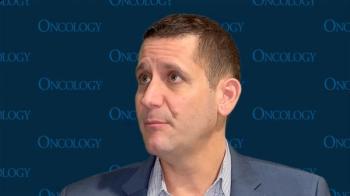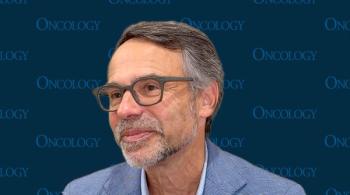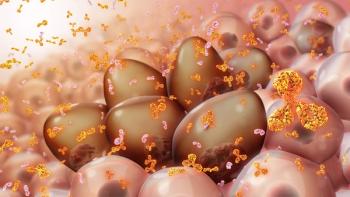
Oncology NEWS International
- Oncology NEWS International Vol 10 No 2
- Volume 10
- Issue 2
Two Cycles of Rituximab Effective in Previously Untreated or First-Relapse Low-Grade Lymphomas
HUDDINGE, SWEDEN-Two cycles of rituximab (Rituxan) are effective and well tolerated in patients with symptomatic previously untreated or first-relapse low-grade lymphomas, reported Eva Kimby, MD. Speaking on behalf of the Nordic Lymphoma Group, Dr. Kimby, who is in the Department of Medicine at Huddinge Hospital, in Huddinge, Sweden, said that early data suggest that the effect of rituximab might be augmented by interferon-alfa-2a (IFN). This phase-II study included researchers from Sweden, Norway, Denmark, and Finland.
HUDDINGE, SWEDENTwo cycles of rituximab (Rituxan) are effective and well tolerated in patients with symptomatic previously untreated or first-relapse low-grade lymphomas, reported Eva Kimby, MD. Speaking on behalf of the Nordic Lymphoma Group, Dr. Kimby, who is in the Department of Medicine at Huddinge Hospital, in Huddinge, Sweden, said that early data suggest that the effect of rituximab might be augmented by interferon-alfa-2a (IFN). This phase-II study included researchers from Sweden, Norway, Denmark, and Finland.
This randomized trial of rituximab vs rituximab/IFN was conducted, Dr. Kimby explained, because rituximab is approved for use in patients with relapsed and refractory follicular lymphoma and because IFN has immune modulating effects and single-agent efficacy in follicular lymphoma. The study enrolled patients with symptomatic previously untreated or first- relapse (< 6 months of low-dose chlorambucil (Leukeran) and/or local radiotherapy) CD20+ low-grade lymphomas. "All patients had indications for treatment and did not have low tumor burdens," Dr. Kimby said.
All patients were treated first with rituximab (375 mg/m2 every week × 4 by IV infusion). Patients were evaluated at weeks 9 and 14. Those in complete remission (CR) at week 14 were observed with no further treatment until symptomatic relapse. Patients with stable disease (SD) or progressive disease (PD) went off study. Those with partial response (PR) or minor response (MR) were randomized to receive either a second cycle of rituximab 375 mg/m2 every week × 4 or IFN (Roferon) 3 million IU/day SC (week 1), 4.5 million IU/day (weeks 2-5) in combination with ri-tuximab 375 mg/m2 every week (weeks 3-6).
Dr. Kimby reported that the study enrolled 127 patients (71 males, 56 females) with "a rather low median age" of 54.1 years (range 26-75 years). Seventy-six percent had follicular lymphomas. Three patients were excluded from treatment, leaving 124 patients. Of these, 65% had stage IV disease, 24% had stage III, and 11% had stage II. Twenty-three percent had elevated LDH levels, and 18% had more than one extranodal site of disease. Ninety patients had no previous treatment, 34 had received previous short-term chlorambucil, 20 had received previous steroids, and 14 had undergone previous radiation therapy.
Response data at week 14 following the first cycles of rituximab were available for 120 of the 124 treated patients and included CR in 11 patients, PR in 56 patients, and MR in 13 patients. (See Table 1.) The 69 patients with PR or MR were randomized to a second treatment cycle of either rituximab alone (n = 36) or rituximab/IFN (n = 33).
Complete response occurred in 8/36 rituximab patients vs 16/33 rituximab/IFN patients. (See Table 2.) Partial responses occurred in 20 rituximab patients vs 15 rituximab/IFN patients.
"Rituximab efficacy might be augmented when combined with interferon," Dr. Kimby said. She also observed that responses were seen in patients with low- and high-intensity CD20 expression on tumor cells.
Toxicity was mild and mostly related to the first infusion in both cycles. In cycle 1, 88% of patients reported side effects. In cycle 2, 33 patients had at least one new side effect. Grade 3 reversible thrombocytopenia occurred in two patients in the rituximab/IFN group. Grade 4 neutropenia occurred in two patients in the rituximab/IFN group. Grade 3 decrease in liver function occurred in one patient in the rituximab/IFN group.
Articles in this issue
almost 25 years ago
Activated T Cells Can Alter Behavior of Leukemic B Cellsalmost 25 years ago
Response Continues for at Least 8 Months with Ibritumomab Tiuxetanalmost 25 years ago
Synthetic Anthracycline Produces High Response Rates in SCLCalmost 25 years ago
Ibritumomab Tiuxetan Produces 73% Response Rate in B-cell NHLalmost 25 years ago
G-CSF Might Prolong Rituximab Responses in NHLalmost 25 years ago
Use of CAD Increases the Early Detection of Breast Cancer by 20%almost 25 years ago
Rituximab Plus Fludarabine May Be Good Alternative to Rituximab Plus CHOPNewsletter
Stay up to date on recent advances in the multidisciplinary approach to cancer.
















































































